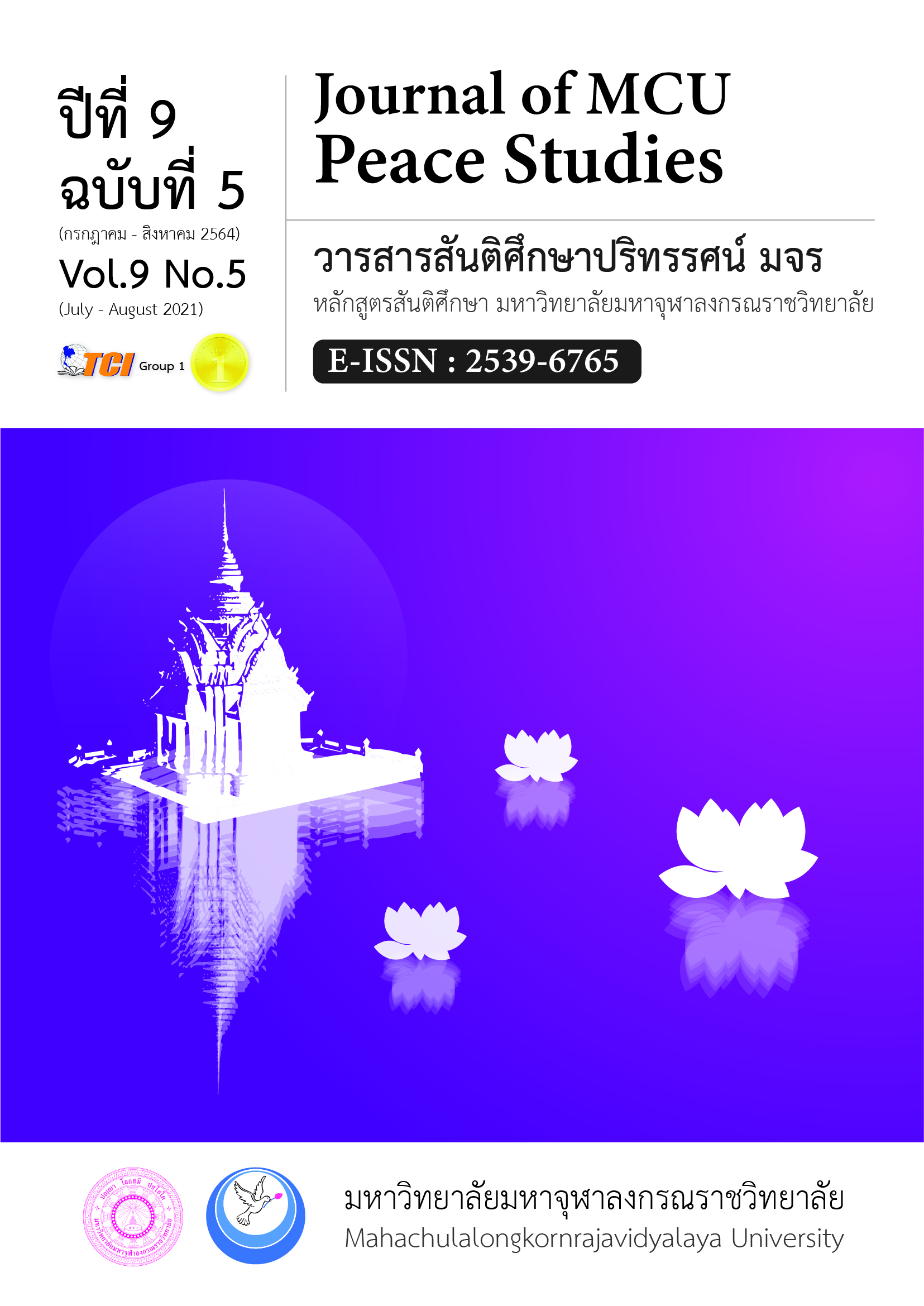Correlation of individual characteristics, sexual cognition and sexual abstinence intention among early adolescents
Main Article Content
Abstract
This research consisted of two objectives, namely: 1) was to study the associations among individual characteristics (gender, family relationships, adolescent living arrangements, parents' marital status, sexual value perception, students' opinions about the ideal age for marriage, frequency of internet or social media use and sexual experience) and sexual cognitions that influenced sexual abstinence intention among early adolescents and 2) to develop a guideline for adolescent health services working with families, schools, and communities and apply the outcomes to promote sustainable sexual abstinence intention. A cross-sectional study was conducted using 164 sixth grade students as participants, with data collected through a self-administered questionnaire. Descriptive statistics were used to analyze the general characteristics. The Mann-Whitney U test and Kruskal-Wallis test were used to compare sexual abstinence intentions and demographics, while differences and associations between sexual abstinence intention and sexual cognition were analyzed using Spearman’s Rho correlation. All participants met the study criteria and completed the questionnaire. From the study, it was found as follows: 1. Factors associating with sexual abstinence intention included gender, sexual value, and marital status of the parents. Also, sexual cognition of the adolescents positively correlated with sexual abstinence intention. 2. The findings can be applied as a guideline for adolescent health services working with families, schools, and communities to promote sustainable sexual abstinence intention among early adolescents.
Article Details
Views and opinions expressed in the articles published by The Journal of MCU Peace Studies, are of responsibility by such authors but not the editors and do not necessarily reflect those of the editors.
References
Ajzen, I. (2011). The theory of planned behavior: Reactions and reflections. Psychol Health, 26(9), 1113-1127.
Alhassan, N., & Dodoo, F.N.A. (2020). Predictors of primary and secondary sexual abstinence among never-married youth in urban poor Accra, Ghana. Reproductive Health, 17(1), 28.
Butcharoen, W., Pichayapinyo, P., & Pawwattana, A. (2013). Factors related to sexual risk behavior among Thai secondary school students. Journal of Public Health, 42(1), 30−40.
Chaikoolvatana, C. et al. (2013). Development of a school-based pregnancy prevention model for early adolescent female Thais. Pacific Rim International Journal, 17(2), 131−147.
Chaiwongroj, C., & Buaraphan, K. (2020). Development and effectiveness assessment of a sex education learning unit for Thai primary students. Journal of Health Research, 34(3), 183-193.
Chokprajakchad, M., Phuphaibul, R., & Phuphaibul, P. (2016). Relation between viewing "Hormones" TV Series* and behaviors among Thai adolescents. Thai Journal of Pedriatric, 55(1), 65-71.
Chokprajakchad, M., Phuphaibul, R., & Sieving, R. E. (2018). Sexual health interventions among early adolescents: an integrative review. Journal of Health Research, 32(6), 467-477.
Chokprajakchad, M., Phuphaibul, R., Sieving, R. E., & Phumonsakul, S. (2020). Effectiveness of parent participation in a technology-based adolescent sexuality education program: a randomized control trial. Pacific Rim International Journal, 24(2), 219-233.
Department of Health, Bureau of Reproductive Health. (2016). The reproductive health situation in an adolescent. Nonthaburi: Bureau of Reproductive Health.
Guilamo-Ramos, V., Lee, J. J., & Jaccard, J. (2016). Parent-adolescent communication about contraception and condom use. JAMA Pediatric, 170(1), 14−16.
Hunchangsithm, P., & Sakulsri, T. (2015). Risk factors influencing teenage pregnancy: a qualitative study. Family and Pregnancy. Institute for Population and Social Research, Mahidol University (pp. 163-180).
Lee, S.Y. et al. (2015). Sexually transmitted infections and first sexual intercourse age in adolescents: the nationwide retrospective cross-sectional study. The Journal of Sexual Medicine, 12, 2313-23.
Morales, A. et al. (2018). Sexual risk among Colombian adolescents: knowledge, attitudes, normative beliefs, perceived control, intention, and sexual behavior. BMC Public Health 18, 1377. from https://doi.org/10.1186/s12889-018-6311-y.
Morales, A. et al. (2019). Adaptation of an effective school-based sexual health promotion program for youth in Colombia. Social Science & Medicine, 222, 207–215.
Neranon, W., Phuphaibul, R., & Kongsaktrakul, C. (2018). Effects to the activity package computer game media on attitude norm and perceived behavior control on sexual abstinence of 7th grade students. Kuakarun Journal of Nursing, 25(1), 73-98.
Pinyopornpanish, K. et al. (2017). Sexual health, risky sexual behavior and condom use among adolescents young adults and older adults in Chiang Mai, Thailand: Findings from a population based survey. BMC Research Notes, 10, 682.
Pojanapotha, P., Singhakant, S., Kaewpornsawan, T., & Apinuntavech, S. (2017). Attitudes and sex education associated with sexual behavior in Thai male students in Bangkok. Journal of Public Health, 47(1), 18-30.
Powwattana, A., & Thammaraksa, P. (2018). Culturally-grounded mother–daughter communication-focused intervention for Thai female adolescents. Nursing & Health Sciences, 20(2), 214-223.
Settheekul, S. et al. (2019). Factors influencing sexual risk behaviors among adolescents: a community-based participatory study. Nursing & Health Sciences, 21(2), 186-197.
Silva, R. N. et al. (2016). Mother–and father–adolescent relationships and early sexual intercourse. Pediatrics, 138(6), 1-9.
Skinner S. R. et al. (2015). Childhood behavior problems and age at first sexual intercourse: a prospective birth cohort study. Pediatrics, 135, 255–263.
Srijaiwong, S., Sindhu, S., Ratinthorn, A., & Viwatwongkasem, C. (2017). Factors Influencing Sexual Behaviors among Thai Adolescents. Journal of Population and Social Studies, 25(3), 171-193.
Sriring, P., Chanaboon, S., & Khonroochinnapong, K. (2014). Knowledge, attitudes, intention and factor effecting intention in prevention of unplanned pregnant and having safe sex between Teenagers in Khon Kaen Province. Rethink: Social Development for Sustainability in ASEAN Community (pp. 470−477).
Taikhanong, K. (2012). The factors influencing of the intention of sexual risk behavior amongst high school students. Christian University of Thailand Journal, 17(1), 168-193.
Widman, L. et al. (2016). Parent-adolescent sexual communication and adolescent safer sex behavior: a meta-analysis. JAMA Pediatric, 170(1), 52-61.
World Health Organization. Report on Global Sexually Transmitted Infection Surveillance 2018. Geneva, World Health Organization. Retrieved February 3, 2021, from https://www.who.int/reproductivehealth/publications/stis-surveillance-2018/en/


